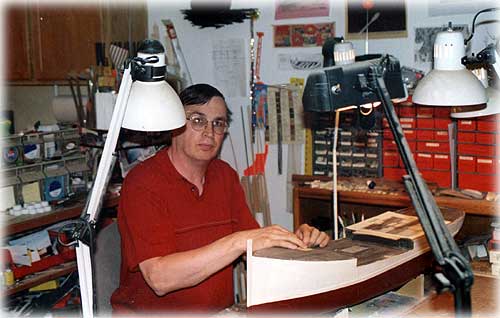 by Louise Brinck Harrington January 08, 2005
 The model was ordered as she looked in the 1940s-1950s.
The Evening Star and the Seymour are both halibut boats equipped with a chute on the stern for letting out the line and a gear puller and rollers for hauling in the fish. Both boats look shipshape as if they're ready to steam to the westward in search of the fishing grounds. You can almost hear the thump of the engines and smell the exhaust. But, wait, don't be so sure! It may be hard to believe, but these boats are models. 
The builder of these boats is Ketchikan resident Terry Richardson, whom many folks know as "the guy who drives around town in the animal control truck." But what many folks don't know is that Richardson leads a double life. By day he works for the Animal Protection Department, true, but by night and on weekends he works at something completely different: He builds boats. Recently Richardson took time out from his busy schedule to drink a cup of tea and talk about model-building-which he refers to as a "hobby." But it's much more than that, as you learn while he talks about all the things involved in building a boat. Things like marine radios, microphones, antennas, radar equipment. And there are fire extinguishers, life rafts, deck pumps, stove pipes. There are even streaks of rust on the stovepipe of the Seymour. Richardson pays close attention to detail. "It's the detail that makes it for me," he says. "It's the detail that matters and makes a boat accurate."  Delivering the Boats Recently Richardson put the
finishing strokes to the Evening Star and the Seymour
and delivered both boats to buyers in Seattle. He arranged to
deliver them to a boat brokerage in Ballard-a place called Dock
Street Brokers, where the buyers agreed to pick them up. But of course the buyers had other ideas. They allowed the boats to stay at the shop for a couple of weeks, but then took them home to enjoy. Building a Model As far as building a model,
"the first step is taking a boat's exact measurements,"
Richardson says. This takes about four full days of work, which
is usually done when the boat is out of the water and includes
"taking the lines off the boat-or what's called lofting
the hull-and measuring everything above the deck." And he
does mean everything: baiting tables, fish bins, all the
gear, masts, booms, the wheelhouse and everything in it.  put there by the owner for doing pull-ups.
From the time he begins the actual building it takes about a year to complete a boat. And remember-that's a year of working at night ("for six hours or so") and on weekends ("pretty much all day"). He uses yellow cedar (which is donated to the cause by sawmill-operator Snapper Carson) for planking and decking and usually builds on a scale of 1/2 inch to the foot. "That makes a nice-sized boat," he says. As Richardson talks, the question inevitably arises: What motivates him to devote so much time and pursue such detail? Preserving History "I look at it as preserving history," he says. "These boats are going by the wayside. There are only about 20 halibut schooners left in existence." He refers to his models as "history in 3-D, where you can walk around and really look at the boats" and believes they'll be important for future researchers. As a boy growing up in Ketchikan
Richardson remembers the fishermen who would hang around the
dockside Tongass Trading store. "Those old guys would sit
around the stove down there and tell stories," he says.
"And I was just this little kid, standing there wide-eyed
and thinking, 'Wow, you did that!'" And those fishermen
had such strong hands "that when I shook hands with them
I wondered if I was going to get my hand back!"  with the Ballard Oil Company calendar.
This took some doing but Richardson complied: He took a picture of the calendar, scanned it on the computer, reduced it down and printed out a tiny-but-exact copy of the original. He added a little backing and, using tweezers, pinned the calendar to the wheelhouse wall. Trademark: A Coffee Cup Though Richardson has built other types of boats, today he specializes in halibut boats and schooners. He loves the looks of the schooners-their fair and graceful lines and the way they glide through the water with very little wake "like a duck," he says. "They're smooth and pretty, if you can call a boat pretty."  The gear puller has over 150 pieces
When the boats are finished, each will have a coffee cup sitting on the hatch cover just like the one on the Seymour. There's a cup on the hatch of the Evening Star too and there's one on every boat Richardson has built. He says he wants to give the impression that a fisherman's been working there on the hatch cover, "and just got up to do something else and left his coffee cup behind." It's a small detail, but it's become his trademark. So if you come across a model with a cup on the hatch cover, you can be sure it's one of Richardson's boats.
|